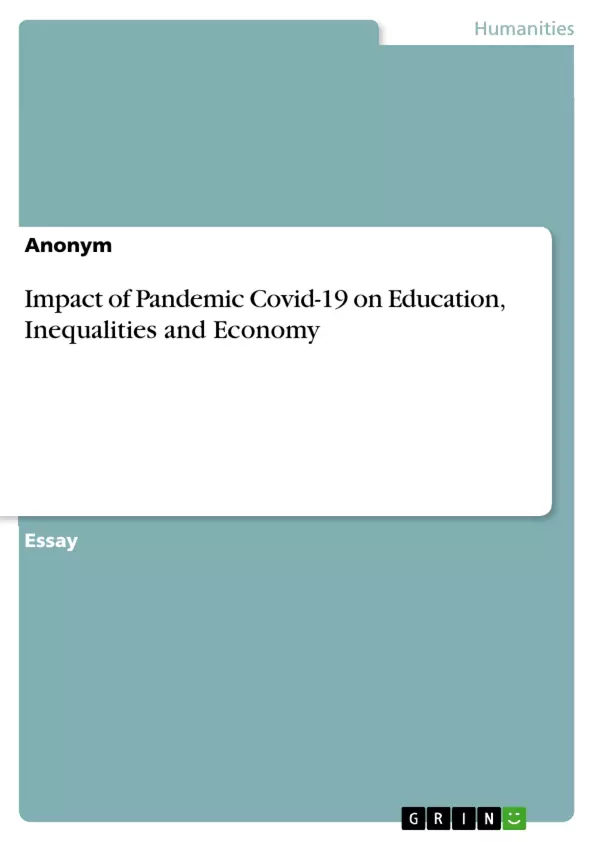The Pandemic, caused by the Virus Covid-19, is accompanied by school closures, social distancing measures and restricting the movement of people, goods and services, leading to stalled economies. „The UNESCO reported that the COVID 19 outbreak disrupted the education of at least 290.5 million students worldwide.“ (https://en.unesco.org/covid19/educationresponse) This leads to a gigantic educational crisis.
While only few schools had the capacity to arrange a distance learning program for their students, not all of the students have the same chances on using it, depending on their social position. While this disruption to education and the expected reduction in global growth have far-reaching effects for all, their impact will be particularly adverse to the most disadvantaged students and their families, especially in poorer countries. Bourdieu, a representative for critical sociology, states that the social success is dependent on the starting requirements, the cultural capital.
Critical sociologists see education as a means for perpetuating class. Using Bourdieu’s Theories on Cultural Capital and Inheritance and the Thesis of Coleman about Social Capital, I would like to point out, how education reproduces inequalities and stratification. Statistic insights of the PISA-Studies and Eurostat, support the arguments, to understand how the current global pandemic could affect education outcomes for years to overcome.
From that point, the paper discusses on the Macro-Level, the relationship between the educational system and the economy, and what costs emerge through the loss of education caused by Covid-19, and it’s impact on the economic growth in the future.
Inhaltsverzeichnis (Table of Contents)
- Introduction
- Social and Cultural Capital
- Bourdieu
- Coleman
- Education reproduces inequalities and stratification
- Covid on Education
- The time factor
- The housing and equipment factor
- The educational level of the parents
- Nutrition
- Interim conclusion
- Impact on Economy
- Conclusion
- Sources
Zielsetzung und Themenschwerpunkte (Objectives and Key Themes)
This paper examines the impact of the Covid-19 pandemic on education, inequalities, and the economy, focusing on how education reproduces social inequalities. It utilizes the theories of Pierre Bourdieu and James Coleman to analyze the role of cultural and social capital in perpetuating class structures. The paper also explores the consequences of school closures and the disruption of education on economic growth, highlighting the disproportionate impact on disadvantaged students.
- The role of cultural and social capital in perpetuating social inequalities
- The impact of the Covid-19 pandemic on education and economic growth
- The relationship between education and economic development
- The reproduction of class structures through the education system
- The challenges of providing equitable educational opportunities during a pandemic
Zusammenfassung der Kapitel (Chapter Summaries)
The introduction establishes the context of the Covid-19 pandemic and its impact on education, highlighting the disruption of learning for millions of students globally. The paper uses the pandemic as a springboard to discuss the underlying structures of social inequality, referencing the theories of Bourdieu and Coleman on social and cultural capital.
The chapter on social and cultural capital delves into Bourdieu's concept of cultural capital, emphasizing how access to education determines life chances and perpetuates social inequalities. The chapter then analyzes Coleman's theory of social capital, focusing on the importance of family support and networks in achieving educational success.
The chapter on Covid's impact on education explores various factors contributing to educational inequalities during the pandemic, such as access to technology, housing conditions, and the educational level of parents. The chapter highlights the challenges faced by disadvantaged students and the potential long-term consequences of the pandemic on education outcomes.
Schlüsselwörter (Keywords)
This paper focuses on the concepts of social reproduction, educational inheritance, social capital, cultural capital, Bourdieu, Coleman, education, and economic growth in the context of the Covid-19 pandemic.
- Quote paper
- Anonym (Author), 2021, Impact of Pandemic Covid-19 on Education, Inequalities and Economy, Munich, GRIN Verlag, https://www.grin.com/document/1292144



